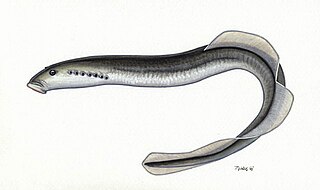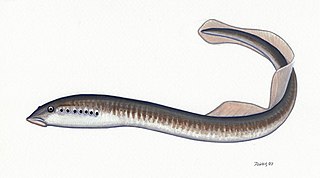
Petromyzontidae are a family of lampreys native to the Northern Hemisphere, comprising the vast majority of living lampreys. Petromyzontids have the highest number of chromosomes (164–174) among vertebrates.

The brook lamprey, also known as the European brook lamprey and the western brook lamprey is a small European lamprey species that exclusively inhabits freshwater environments. The species is related to, but distinct from, the North American western brook lamprey.

The Arctic lamprey, also known as the Japanese river lamprey or Japanese lampern, is a species of lamprey, a jawless fish in the order Petromyzontiformes. It inhabits coastal freshwater habitat types in the Arctic. Some populations are anadromous, spending part of their lives in the ocean. It is the most common and widespread lamprey in the Arctic region.

The European river lamprey, also known as the river lamprey or lampern, is a species of freshwater lamprey.

The western brook lamprey is a small (<18 cm), widely distributed, non-parasitic species of jawless fish endemic to the freshwater coastal waterways of the Western United States and Canada. Its range extends from the North American Pacific coast from Taku River, southern Alaska, Queen Charlotte Islands, to central California, including Vancouver Island, with major inland distributions in the Columbia and Sacramento-San Joaquin watersheds.

Eudontomyzon danfordi, the Carpathian brook lamprey or Danube lamprey, is a species of lamprey in the family Petromyzontidae. It is found in Austria, Bosnia and Herzegovina, Bulgaria, Croatia, Czech Republic, Hungary, Moldova, Romania, Serbia, Montenegro, Slovakia, and Ukraine. Unlike other brook lampreys, this fish is parasitic.

Eudontomyzon is a genus of lamprey in the family Petromyzontidae. Most species are found in Eastern Europe.
The Greek lamprey is a species of jawless fish in the Petromyzontidae family. It is endemic to Greece. Its natural habitats are rivers and freshwater springs. It is threatened by habitat loss. Originally considered a species of the genus Eudontomyzon, later phylogenetic analyses suggested that a placement within Caspiomyzon was more likely. It is the most endangered species of lamprey, living only in the Strymon and Louros river basins.

The Ukrainian brook lamprey is a species of lamprey in the Petromyzontidae family. It is found in brackish and freshwater areas in Austria, Belarus, Bulgaria, the Czech Republic, Georgia, Hungary, Moldova, North Macedonia, Poland, Romania, Russia, Serbia and Montenegro, Slovakia, Turkey, and Ukraine. It invaded the basin of the Volga River in 2001.
Eudontomyzon vladykovi, or Vladykov's lamprey, is a species of lamprey in the family Petromyzontidae. It is found in Austria, Germany, The Czech Republic, Bulgaria, Romania, Serbia, and Montenegro.

Lampetra is a genus of lampreys in the family Petromyzontidae.

The lake lamprey, Entosphenus macrostomus, also known as the Vancouver lamprey or Cowichan lamprey, a recent derivative of the Pacific lamprey, is a species of freshwater lamprey endemic to two North American lakes: Lake Cowichan and Mesachie Lake in Vancouver Island, Canada. The lamprey was originally called the Vancouver Island lamprey, until an error in filing shortened it to the Vancouver lamprey. The alternate common name of "Cowichan lamprey" was coined and promoted by the species' describer, Dr. Dick Beamish, who originally identified the species in the 1980s.
The Miller Lake lamprey is a species of lamprey in the Petromyzontidae family endemic to the United States. Its natural habitat is the Miller Lake drainage in the state of Oregon.

Lethenteron is a genus of lamprey in the family Petromyzontidae.

Lampreys are a group of jawless fish comprising the order Petromyzontiformes. The adult lamprey is characterized by a toothed, funnel-like sucking mouth. The common name "lamprey" is probably derived from Latin lampetra, which may mean "stone licker", though the etymology is uncertain. Lamprey is sometimes seen for the plural form.

Eudontomyzon stankokaramani, the Drin brook lamprey, is a non-predatory, freshwater resident species of lamprey found in the Drin river system of Albania and Kosovo and the basins of Lakes Ohrid and Shkodra.
The Caspian lamprey, Caspiomyzon wagneri, is a species of lamprey native to the Caspian Sea, and a member of the Petromyzontidae family. This species is a non-parasitic lamprey that feeds on animal carcasses.
The least brook lamprey is a common, non-parasitic lamprey distributed in the Mississippi River watershed, and a limited range along the Atlantic coast.
Entosphenus is a genus of lampreys.

Lampetra ayresii is a species of lamprey in the family Petromyzontidae. It is also called the river lamprey or western river lamprey. It is found in the eastern Pacific, specifically from Tee Harbor, Juneau in Alaska to the Sacramento–San Joaquin drainage in California, USA. It can survive in both marine surface waters and freshwater lakes, rivers, and creeks. In freshwater, it is found typically in the lower portions of large river systems. It is a predatory fish and feeds on fishes in the size range of 10–30 cm. It feeds by attaching to prey using its round, sucker-like mouth. Adult western river lampreys typically grow to about 21 cm (8.3 in) total length (TL), but can reach 31 cm (12 in) TL.












